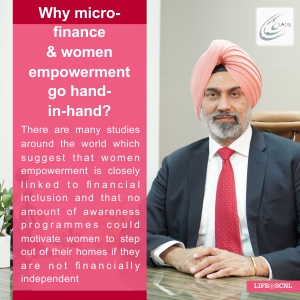
There are many studies around the world which suggest that women empowerment is closely linked to financial inclusion and that no amount of awareness programmes could motivate women to step out of their homes if they are not financially independent
As the Indian economy went through liberalization in the early 90s, there were several reforms and the economic growth was on an upwards trajectory. However, this also opened up another debate- is this growth reaching every section of the society, or being restricted to crème de la crème. By World Bank estimates in 2018, India witnessed the fastest rise in inequality of all major world regions between 1980 and 2016, and 55% of the country’s income share is in the hands of the wealthiest 10%. The gap is because of the uneven spread of income in rural, semi-urban, and urban areas. As per the 2011 census, about two-thirds of the India population lives in rural areas. They are constantly challenged with a shortage of services such as banking and health care. As a result, the true potential of rural India is yet to be fully harnessed, particularly that of women who possess great entrepreneurial skills and leadership abilities.
There are many studies around the world which suggest that women empowerment is closely linked to financial inclusion and that no amount of awareness programmes could motivate women to step out of their homes if they are not financially independent. In the absence of formal banking services and credit facilities in the remotest parts of the country, Micro-finance Institutions have played a commendable role in empowering women and providing them with easy credit access, in the form of loans, thus giving wings to their dreams. Because an empowered and financially independent woman can significantly contribute to the health and productivity of her family and community.
In this context, it is noteworthy to hearken to the words of Prime Minister Narendra Modi who, applauding the role of women in building a healthy society, stated that no country can progress if its women are not equal partners in the developmental process. Nevertheless, it is worrying to see that despite this understanding and awareness, India ranks 108 among 144 countries in the Global Gender Gap Report by the World Economic Forum (WEF) conducted in 2017. The report further highlights that along with other parameters, ‘economic participation and opportunity’, remains a key challenge for women as the nation managed 139 ranks on this parameter. Women’s labour participation in India is a meagre 28%.
According to the Sixth Economic Census by the Ministry of Statistics and Programme Implementation, women constitute around 14 per cent of the total entrepreneurship in India. 98 per cent of them work in the informal sector. The Global Findex Survey suggests that only 5 per cent Indian women with bank accounts receive bank loans compared to 11 per cent in China. Hence, they often end up limiting their business within the boundaries of their locality or borrow from informal sources, at a much higher rate of interest, thus making their products or services uncompetitive.
Microfinance, with its reach and connect with the rural population, is widely seen as an effective tool to reach out to the underbanked yet aspiring women who are determined to bring about a change in society. The significance of microfinance institutions (MFIs) in the country can be understood from the recent rise in borrowings by women. According to MicroFinance Institutions Network, there were more than 2.65 Crore borrowers associated with these institutions with the outstanding Gross Lending Portfolio of Rs. 1,48,097 Crores as of June 2018. Majority of them are women, who do not have access to formal credit. The launch of MUDRA scheme and institutional provisions like revised RBI guidelines for NBFC-MFIs have provided the necessary boost to the industry.
Further, Micro-finance institutions connect women entrepreneurs through small joint liability groups. Each member of the group receives a certain amount of loan without any collateral or cumbersome documentation process, which can be used for income generation purposes like animal husbandry, agriculture, handicraft, trading and other forms of business. More importantly, the presence of branches even in the remotest parts of the country implies that easy access to loans and streamlined disbursal processes. Experience suggests that women are more financially disciplined as compared to men. Thus, there is a far more social value generated when women access formal credit. Thus, each micro-loan that is disbursed to women entrepreneurs goes a long way towards multiplying jobs, poverty alleviation and creation of a prosperous society.
Thus, it can be argued that financial inclusion plays a key role in empowering women and preparing them for greater roles as contributors to national growth. However, this is a collective responsibility that should be shared by the banking communities, Micro-finance institutions and the Government alike. It’s no easy task to build a financially inclusive and empowered society, taking into account India’s geographic and demographic diversity with protruding educational backwardness. Therefore, a comprehensive action plan needs to be put in place that not only aims at a financially inclusive society but also empowering and equipping the women with the basic skills of self-employment. This will undoubtedly lay the foundation for a new and progressive India, rooted in self-reliance and economic resilience.
By H P Singh, Chairman and Managing Director, Satin Creditcare Network Limited. Views are the author’s own.
- Date: Jan 23, 2019
- Client: Mr H P Singh
- Category: Blogs
